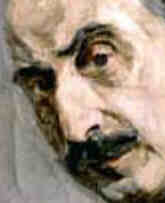 ^
Born on 20 July 1847: Max
Liebermann, German painter of portraits, figures, and landscapes,
draftsman, printmaker, and collector, who died on 08 February 1935.
^
Born on 20 July 1847: Max
Liebermann, German painter of portraits, figures, and landscapes,
draftsman, printmaker, and collector, who died on 08 February 1935. — Born in Berlin of Jewish parents, he studied under Carl Steffeck from 1866 to 1868 and at the art school in Weimar from 1868 to 1872. First visited Paris and Holland in 1872, then lived mainly in Paris from 1873 to 1878, with visits in the summers of 1874 and 1875 to Barbizon and afterwards to Holland. He was influenced by Hals, Millet, and Israels, and made studies from nature and paintings of peasant life. He moved in 1878 to Munich and in 1884 to Berlin.
After 1890 Liebermann was somewhat influenced by French Impressionism, tending to use lighter colors and a sketchier, more atmospheric technique. He later collected Impressionist pictures and published essays on Manet and Degas. An exhibition of his work as part of the Grosse Berliner Kunstausstellung in Berlin in 1897 led to increased recognition, and in 1899 he was made President of the Berlin Secession. From 1909 he worked mainly in and around his country house at Wannsee, near Potsdam. He was president of the Prussian Academy from 1920 to 1933, but compelled to resign his numerous honors after the rise to power of the Nazis. Lieberman died in Berlin.
— Liebermann dominated the German art world from the 1890s to the 1930s. Although at first a highly controversial figure, after the turn of the century he was showered with honors. His Naturalist and Impressionist works have been consistently admired, despite being banned during the Nazi period. Liebermann’s approach was that of a liberal cosmopolitan, and his work is distinguished by its honesty and commitment to social reform. Influenced by Dutch and French painting, he led the modernist movement in Germany away from the literary art of the 19th century.
— Giorgos Bouzianis and Lasar Segall were students of Liebermann.
— LINKS
— Self-Portrait (1934, 92x73cm) _ Liebermann painted self portraits throughout his life. Along with Lovis Corinth and Max Beckmann, Liebermann's devotion to self-portraiture produced many moving and acute testimonies to artistic self-examination. Liebermann frequently portrayed himself before the easel or in the studio, smartly dressed and in the act of painting. This picture is Liebermann's final self portrait, completed when he was 88, a year before his death. His gaze appears resigned and the mood of the painting subdued. The previous year, after the accession to power of the National Socialists, Liebermann had been summarily relieved of the presidentship of the Prussian Academy and his numerous other honours because he was Jewish.— Self-Portrait (lithograph 21x17cm) — Large Self-Portrait, standing and sketching (1912 lithograph 39x29cm) — Self-Portrait in Profile to the right (drypoint 24x16cm) — Self-Portrait, at the easel (1913; 491x400pix, 43kb) — Self-Portrait, Sketching (1921 etching 25x18cm) — Self-Portrait wearing a hat (1920 lithograph 22x17cm) — Self-Portrait with brush in hand (etching, 23x17cm)
— Professor Richard Cassirer (1918, 96x78cm) _ Liebermann painted numerous portraits throughout his life, including many of friends and acquaintances living in Berlin. Professor Richard Cassirer was born in 1868 in Breslau and was Professor of Neurology at Berlin University between 1912 and 1925, the year of his death. His brother Paul Cassirer, a prominent art dealer, commissioned this portrait on the occasion of Richard Cassirer's fiftieth birthday. Cassirer sat for the portrait in Liebermann's studio, which was in the attic of his Berlin house right next to the Brandenburg Gate. The portrait was shown during the summer of 1918 at the Free Secession exhibition.
— Kaiser Friedrich Gedächtnisfeier in Kösen (1888, 93x64cm) _ This depicts the memorial service for Kaiser Friedrich III [18 Oct 1831 – 15 Jun 1888], who 99 days after ascending to the throne (09 March 1888) already moribund from throat cancer. Liebermann was in Kösen in the Thuringian Forest between spring and late summer of that year. He made and later exhibited several oil paintings of the same subject, one of which was destroyed in 1945. This painting was inspired by Mission Service in the Beech Wood at Kösen painted 20 years earlier by Adolf von Menzel [1815-1905]. Both the subject and the general composition is similar to Menzel's painting of 1868.
— Nach dem Baden (1904, 63x91cm) _ From very early in his career Liebermann frequently painted children, particularly orphans, either playing or working. His earliest works on the theme of childhood were painted at a time when Liebermann was influenced by Dutch painters of the 17th century, particularly Frans Hals. His first paintings of bathers were made in the mid-1870s. He remained deeply attached to Holland throughout his life, frequently visiting the coast around Scheveningen. This is the second of two oil paintings, based on sketches Liebermann made on the Dutch coast in 1903. The figure in the middle appears rather stiffly posed, while the other boys are depicted more naturalistically.
— Country Tavern at Brunnenburg (1893)
— On the Way to School in Edam (1904) [nothing cheesy about this picture or the next]
— The Ropewalk in Edam (1904, 101x71cm) _ Liebermann painted this during a visit to the small Dutch town, about 20 km northeast of Amsterdam near the Zuider Zee. The painting illustrates laborers manufacturing rope by twisting strands of fiber together. The work was done along a path known as a ropewalk. In the background is the canal that links Edam to the Zuider Zee. The picture's surface and strong color were developed from a careful study of Impressionism in the 1870s and 1880s.
— Der Barmherzige Samariter (1910 Drypoint 20.2 x 24.1 cm)